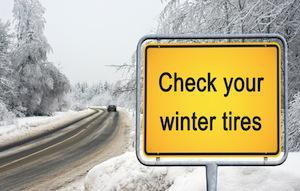
Plan and Prepare
Effective planning and preparation can go a long way in preventing an automobile accident. Proper preparedness can also help to decrease your risk of exposure and resulting health complications, should you end up stranded because of an accident or car troubles. Ensure you cover both by:
-
Performing winter maintenance on your car (check battery and tire tread, fill washer fluid reservoir with no-freeze fluid, replace windshield wipers, etc.);
-
Having a winter safety kit on hand (flashlight, batteries, battery-operated radio, shovel, an abrasive material like sand or kitty litter, ice scraper, warning devices, warm blankets and extra clothes, food and water, cell phone, jumper cables, etc.);
-
Planning your route ahead of time, familiarizing yourself with directions or maps, and allowing extra time for unexpected situations;
-
Letting friends, family, co-workers, or other points of contact know of your expected arrival time; and
-
Practicing cold weather driving in daylight hours in an empty lot or other safe area covered with either snow or ice.
Protect Yourself
If you are planning to drive—whether it be a short distance or a long one—remember the basic of protecting yourself and your family: always buckle up, place children in safety seats in the back, and never place a rear-facing infant seat in front of an airbag. You should also know what to do to protect yourself and your children, should you end up stuck on the side of the road. Follow these recommendations:
- Do not travel outside unless absolutely necessary;
- Place bright markers on the antenna and/or windows of your car;
- Avoid over-exerting yourself;
- If you run your car, do so just enough to keep it warm (also, be sure to clear the area around your exhaust pipe of any snow);
- Use blankets or extra clothing to protect from hypothermia; and
- Attempt to remain calm until help arrives.
Prevent Accidents with Safe Winter Driving
Most of the rules of safe winter driving are the same as the rules that apply to everyday driving—do not drink and drive, watch for pedestrians, follow and obey all traffic signs, avoid fatigue—however there are also additional rules that are specific to winter weather driving, including:
- Permitting extra distance for stopping;
- Slowing down to give yourself more time to react to emergent situations;
- Knowing how your braking system operates on ice and snow (stomp on antilock, pump non-antilocks); and
- Increasing the distance between your vehicle and the vehicle in front of you.
What to Do If an Accident Occurs
Even when you prepare, protect yourself and passengers, and follow all the driving rules, accidents can and do happen. If one happens to you and you are injured in the process, know that you may be entitled to receive compensation, even if no one was at fault. It should be noted, however, that such cases are often complex, and insurance companies will attempt to avoid paying out or reduce your compensation.
The Appleton automobile accident attorneys and Green Bay automobile accident attorneys at [[title]] can help protect your rights and best interests during the claim process. If necessary, they can also provide the skills, resources, and knowledge needed to aggressively pursue more difficult injury claims. Learn how their offices may be able to help you in your case by scheduling your free initial consultation. Call 920-739-7366 today.
Sources:
http://fox6now.com/2016/01/01/three-die-in-two-vehicle-crash-in-northeastern-wisconsin/
https://www.osha.gov/Publications/SafeDriving.pdf



